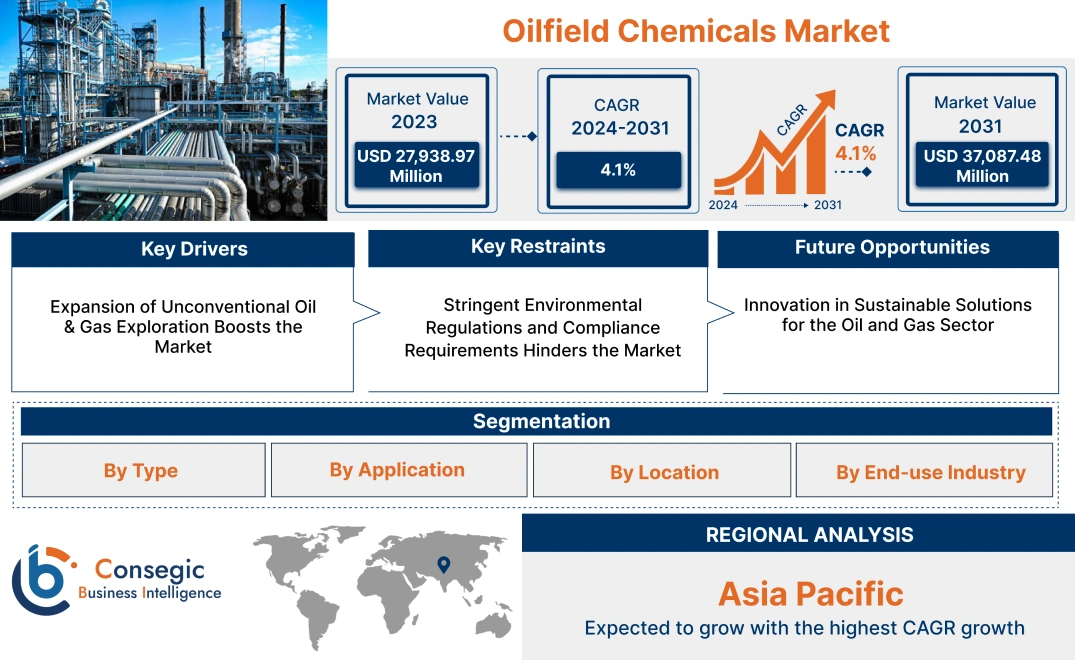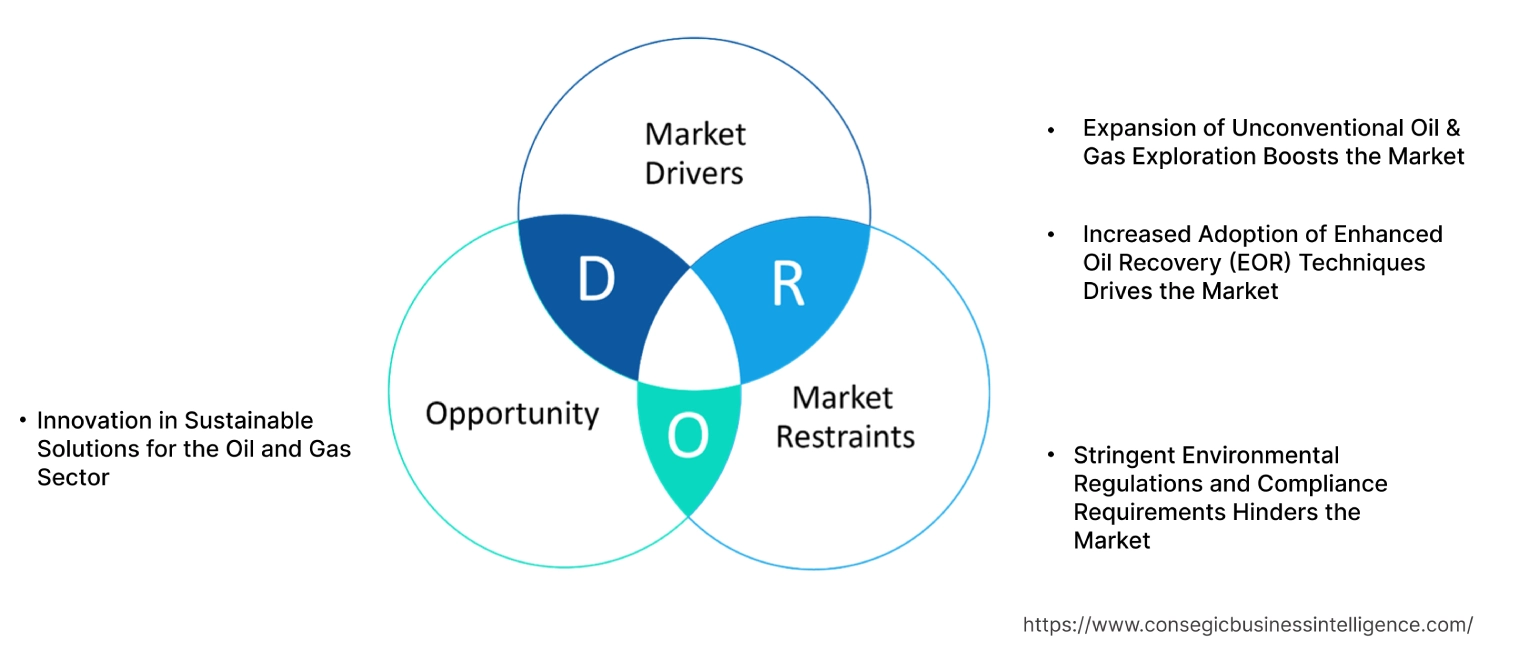- Summary
- Table Of Content
- Methodology
Oilfield Chemicals Market Size:
Oilfield Chemicals Market size is growing with a healthy CAGR of 4.1% during the forecast period (2024-2031), and the market is projected to be valued at USD 37,087.48 Million by 2031 from USD 27,938.97 Million in 2023.
Oilfield Chemicals Market Scope & Overview:
Oilfield chemicals are used for oil and gas extraction operations to improve the efficiency of operations including, production as well as exploration of oil and gas. They can be used to enhance the drilling fluids conditions, along with damage control, enabling them to be adopted as corrosion prevention equipment. The advantages include equipment life extension, improvement in resource recovery, minimization of environmental impact, and others. The applications range from drilling additives and production chemicals to well stimulation and cementing. The primary end-users include oil and gas exploration companies, drilling contractors, and oilfield service firms.
Oilfield Chemicals Market Insights:
Key Drivers:
Expansion of Unconventional Oil & Gas Exploration Boosts the Market
Novel oilfield chemicals for optimizing complicated and novel techniques are required for the extraction of shale gas and tight oil. To ensure the streamlining of operations in hostile geographical environments Drilling fluids, corrosion inhibitors, and cementing agents are of great significance.
Moreover, these chemicals are utilized in processes like hydraulic fracturing, well drilling, and stimulation, as there is an increase in the exploitation of unconventional resources by energy companies.
- In September 2021, the Appalachian Basin reached a record production for shale natural gas. During the first half of the year, the average production was 31.9 billion per day.
Therefore, the increasing focus on the extraction of unconventional oil and gases drives the oilfield chemicals market growth.
Increased Adoption of Enhanced Oil Recovery (EOR) Techniques Drives the Market
EOR has now become an important technology when it comes to the extraction of trapped oil from mature fields. The process involves the injection of specific chemicals, such as surfactants, polymers, and alkalis, into the reservoirs to enhance the flow of the oil, which eventually increases the efficiency. Advanced methods of oil recovery like EOR are pretty common these days and are heavily used to extract remaining oil in many maturing conventional oilfields.
- For instance, in July 2023, ExxonMobil signed an agreement to acquire Denbury Inc., one of the leading players in enhanced oil recovery methods. It increases the scale of its EOR operations with the addition of Denbury's advanced CO2-enhanced oil recovery operations.
Therefore, the market trends analysis depicts that the increased use of enhanced oil recovery techniques demonstrates the vital role of oilfield chemicals in optimizing extraction efficiency and extending the life span of reservoirs.
Key Restraints :
Stringent Environmental Regulations and Compliance Requirements Hinders the Market
Oilfield operations involving hazardous chemicals are regulated by the environmental authorities, reducing the risk of releasing harmful chemicals into the soil and water. They operate by controlling the application of toxic chemicals used in the operations. This leads to companies using less hazardous chemical substitutes, at the expense of the more efficient ones, which in turn to companies investing more in the measures to ensure compliance with regulatory measures.
- In December 2023, methane and other pollutants were significantly cut from the oil and natural gas operations , by the rule enacted by EPA.
As per the market trends analysis, stringent environmental regulations and compliance requirements restrain the oilfield chemicals market demand.
Future Opportunities :
Innovation in Sustainable Solutions for the Oil and Gas Sector
In order to minimize the environmental impact as well as ensure operational efficiency, there has been a growing focus on sustainability leading to numerous innovations. Biodegradable drilling fluids, nontoxic surfactants, and environmentally safe inhibitors are a few of the green alternatives that reduce environmental harm. Moreover, with the introduction of strict regulations and sustainability goals, there is a surge towards biodegradable drilling fluids, further enhancing oilfield operations.
- In September 2022, the D3 program by Clariant Oil was launched to meet the sustainability demands of the oil and gas industries. The program includes multiple eco-friendly solutions such as FOAMTREAT WET, PHASETREAT™ WET, and WAXTREAT™ SZ.
Therefore, the market analysis depicts that the focus on sustainability and regulatory measures continues to accelerate the oilfield chemicals market opportunities.
Oilfield Chemicals Market Segmental Analysis :
By Type:
By type, the market is segmented into Drilling Fluids, Production Chemicals, Stimulation Chemicals, Cementing Chemicals, Enhanced Oil Recovery (EOR) Chemicals, Workover & Completion Fluids, and Others.
Trends in the Type:
- Due to environmental concerns and the ability to surpass production challenges, bio-based production chemicals are gaining traction.
- Low-viscosity fluids are being developed and researched, with the new advances in fracturing fluids.
Drilling fluids accounted for the largest revenue of the total oilfield chemicals market share in 2023.
- Applications including cooling and lubrication of the drill bit, transportation of cuttings to the surface, and stabilization of wellbore, are done using drilling fluids. They are also known as muds.
- These fluids are of use when it comes to sustaining the integrity of the bore, improving the efficiency of drilling, and formation damage control.
- For instance, the high-performance water-based mud by Nviros™, is a more efficient drilling fluid, with better drilling and lubricating capabilities, increasing the overall rates of penetration (ROP).
- Therefore, the continuous advances and numerous advances drive the oilfield chemicals market demand.
Enhanced Oil Recovery (EOR) Chemicals is anticipated to register the fastest CAGR during the forecast period.
- When methods including chemical flooding, injection of gas, and thermal recovery are applied to extract oil from reservoirs at a very high level is called Enhanced Oil Recovery (EOR).
- These chemicals lower viscosity and increase the movement of oil from reservoir rock to enhance the oil recovery process.
- Moreover, oil production and the need to extract more from oil fields is gaining traction.
- In September 2023, a new brand name Tiorco was announced by Stepan Company, as a joint venture with Nalco Holding Company, to further develop the Enhanced Oil Recovery technologies.
- Hence, as per the segmental analysis, the EOR sector is seeing rapid growth in the oilfield chemicals market trends due to the increasing demand for oil recovery and enhanced processes.
By Application:
By application, the market is segmented into Drilling, Cementing, Stimulation, Production, Enhanced Oil Recovery (EOR), and Workover & Completion.
Trends in the Application:
- Ongoing developments like water-based drilling fluids are more sustainable options and ecologically less harmful.
- Innovations such as high-performance stimulation fluids are also gaining traction, for multi-complex reservoirs.
The production sector accounted for the largest revenue share of 32.11% in 2023.
- Production chemicals including inhibitors that enable the prevention of corrosion, scaling, and emulsification in the produced fluids, are utilized to maintain and optimize oil and gas production.
- They ensure the overall efficiency of production by smoothening the production facilities and ensuring equipment integrity.
- Moreover, there is an increasing demand for efficient chemical solutions and oil and gas production.
- For instance, a production chemical called ERCABAC 80 by Syensqo is used to prevent the formation of sulfurous gases and reduction of pipeline corrosion, acting as a de-emulsifier and sludge breaker.
- Therefore, the growing requirement for improved chemical solutions and optimization of oil and gas production drives the oilfield chemicals market growth.
Enhanced Oil Recovery (EOR) is anticipated to register the fastest CAGR during the forecast period.
- Several advanced chemicals including surfactants, polymers, and alkaline agents are used to enhance the oil extraction process from reservoirs, for EOR.
- They improve the efficiency of the process of extraction and oil displacement.
- Additionally, there are multiple ongoing innovations in the field, owing to the growing need for extraction of oil.
- In October 2021, LUKOIL signed an agreement with Gazprom Neft, to enter into a joint venture for enhancement of oil recovery technologies. Research and development of various oil recovery methods will be performed together by both companies.
- Therefore, the new advances and increasing requirements for oil extraction drive the oilfield chemicals market opportunities.
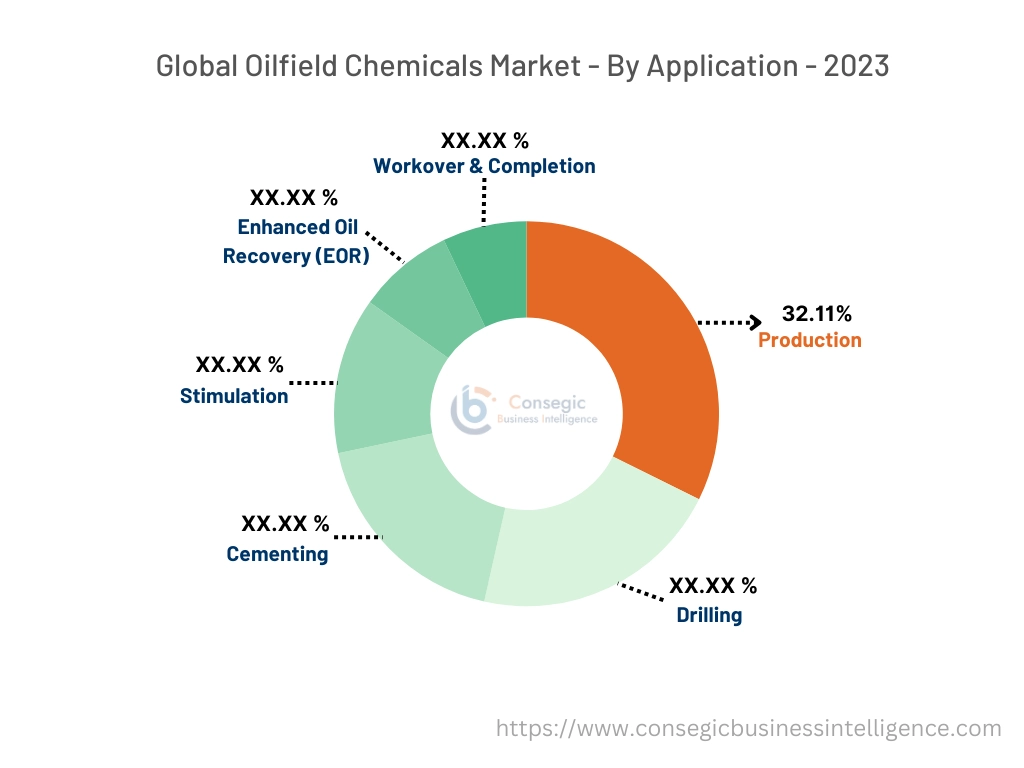
By Location:
Based on location, the market is segmented into Onshore and Offshore.
Trends in the Location:
- Automated chemical injection systems are used to reduce the overall cost in terms of onshore applications, as well as improve precision.
- The extraction capabilities from offshore areas are done using Chemical deepwater solutions as even under unfriendly conditions they are still resilient.
Onshore accounted for the largest revenue of the total oilfield chemicals market share in 2023.
- A range of specialized oil and gas extraction activities and chemicals can be accessed with the drilling, production, and reservoir conditions, in onshore locations.
- There has been continuous exploration and production in oil fields based on land, in turn accelerating the onshore sector.
- Moreover, several explorations and production in oil fields based on land have been done.
- In February 2023, a strategic $1.4 billion purchase of 2,300 wells was done by INEOS Energy in Eagle Ford shale from Chesapeake Energy. This acquisition allows the expansion of the onshore oil and gas market for INEOS in the US.
- Recent innovations including subsea robotics and real-time monitoring systems improve operational efficiency and ensure safety in offshore drilling processes.
- Therefore, the advances in offshore drilling technologies and operational efficiency drive the oilfield chemicals market expansion.
Offshore is anticipated to register the fastest CAGR during the forecast period.
- Offshore extraction is performed utilizing mechanical and chemical operations, either in shallow or deep waters, designed to conditions including bad weather and complicated logistics.
- Moreover, there is also an increase in the exploratory and advanced technology in the offshore sector.
- In September 2022, the Fenix Offshore Gas Project was sanctioned USD 706 million by TotalEnergies. Existing infrastructure is utilized to enhance the production levels and supply to Argentina.
- Advances in technology including autonomous underwater vehicles (AUVs) and subsea robotics are increasing the overall safety and efficiency of offshore drilling.
- Thus, technological advancements and growing investment in offshore explorations drive the oilfield chemicals market trends.
By End-Use-Industry:
By end-use industry, the market is segmented into Power Generation, Oil & Gas, Chemicals & Petrochemicals, Food & Beverage, Pharmaceuticals, and Others.
Trends in the End-Use-Industry:
- To ensure the safety and efficiency of operations in oil and gas, technologies like Real-time monitoring systems are integrated to enhance performance.
- Process and procedures of handling and application of service companies are optimized by developing platforms for chemical management.
Oil & Gas companies accounted for the largest revenue share in 2023
- For the improvement of processes like exploration, drilling, production, and recovery oil and gas companies are using oilfield chemicals.
- Moreover, chemicals for exploration and production activities are in high demand.
- There is an increase in high-performance additives and eco-friendly options, to improve operational efficiency, reduce environmental impact, and comply with the strict environmental laws.
- Therefore, due to high dependency on operation processes oil and gas companies account for the largest sector in the market.
Service Companies are anticipated to register the fastest CAGR during the forecast period.
- With adequate chemical solutions specialized services like maintaining exploration of oil and gas, drilling, and production operations are provided by the service companies.
- Additionally, sophisticated chemical solutions and support services are in high demand across organizations.
- To optimize chemical applications and improve operational efficiency service companies are increasingly utilizing advanced technologies like data analytics and machine learning. The enhancement of overall effectiveness and customized chemical solutions for specific needs are achieved with the integration of real-time monitoring and predictive maintenance.
- Hence, as per the oilfield chemicals market analysis, the growth is driven due to the various chemical solutions and services offered by service companies that drive the oilfield chemicals market expansion.
Regional Analysis:
The regions covered are North America, Europe, Asia Pacific, the Middle East and Africa, and Latin America.
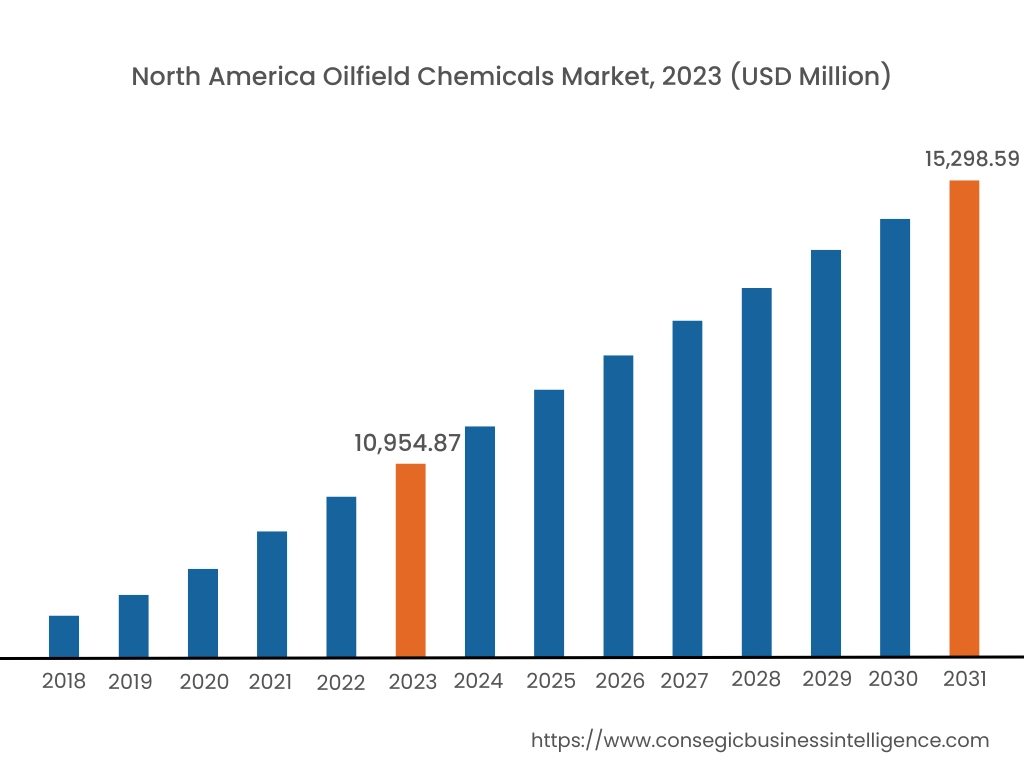
In 2023, North America accounted for the highest market share 39.21%, and was valued at USD 10,954.87 million, and is expected to reach USD 15,298.59 million in 2031. In North America, the U.S. accounted for the highest market share of 71.27% during the base year of 2023. The growth is driven by the ongoing oil and gas operations using advanced oilfield chemicals, to ensure minimized environmental impact. Hydraulic fracturing technologies are also seeing advancements in this region, including the increase in drilling activities.
- In February 2023, Imperative Chemical Partners, Inc. partnered with RSI to expand the oil and gas production chemicals business in the U.S., launching a wide range of products in the marketplace.
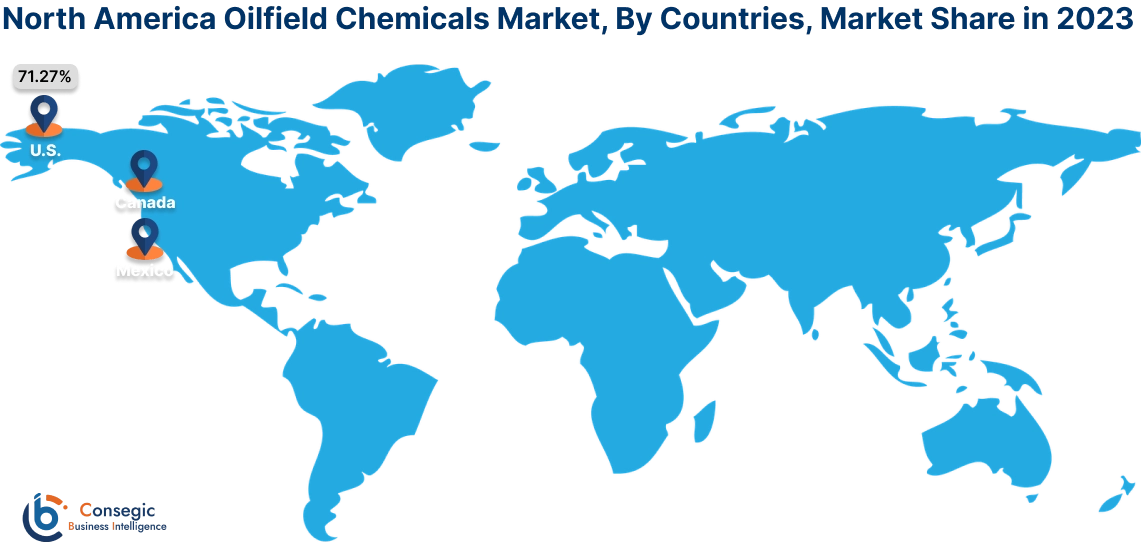
Asia Pacific region has the fastest CAGR of 4.9% during the forecasted period. As per the oilfield chemicals market analysis due to the projects involving offshore and onshore drilling, especially in countries like China and India, which require a range of oilfield chemicals, including drilling fluids, corrosion inhibitors, and cement additives. There is also a rapid increase in oil and gas exploration activities, further accelerating the market.
- In November 2021, Sinopec announced the production of 1 million tons of capacity of shale oil in the next five years utilizing the Shengali Oilfield shale oil.
The stringent regulations revolving oil and gas extraction process, drives the growth of the market in Europe, especially in terms of eco-friendly oilfield chemicals. The heavy investment in oil and gas infrastructure, especially in countries like Saudi Arabia and UAE, is the primary driving factor for the growth in the Middle East and African markets. In Latin America expansion in the offshore drilling operations is the primary driving factor.
Top Key Players & Market Share Insights:
The oilfield chemicals market is highly competitive with major players providing products to the national and international markets. Key players are adopting several strategies in research and development (R&D), product innovation, and end-user launches to hold a strong position in the global oilfield chemicals market. Key players in the oilfield chemicals industry include -
- Ecolab (U.K.)
- BASF (Germany)
- Dow (U.S.)
- Stepan Company (U.S.)
- Halliburton (U.S.)
- The Lubrizol Corporation (U.S.)
- Croda International Plc. (U.K.)
- Pon Pure Chemicals Group (India)
- Kemira (Finland)
- Solvay (Belgium)
- Albemarle Corporation (U.S.)
- Clariant (Switzerland)
Recent Industry Developments :
Product Launches:
- In April 2024, BP announced the beginning of the ACE platform. The platform, which is the seventh installed on the giant ACG field, represents BP's most technologically and digitally advanced offshore platform controlled onshore. It has been designed to process up to 100,000 barrels of oil per day, with ACE expected to produce up to 300 million barrels over its lifetime
- In March 2024, CNOOC Limited announced a significant oilfield discovery in Kaiping South of the South China Sea, adding more than 100 million tons of oil equivalent to its proved in-place volume. The structure consists of the Zhuhai, Enping, and Wenchang Formations situated in the eastern South China Sea at water depths of about 500 meters. Testing of the discovery well KP18-1-1d produced an average of approximately 7,680 barrels of crude oil and 0.52 million cubic feet of natural gas per day.
Expansions:
- In May 2024, BASF announced an investment in further increasing the production capacity of its Basoflux® paraffin inhibitors at the site in Tarragona, Spain. This investment enables the production of new, sustainable aqueous-based dispersions and solvent-based paraffin inhibitors that BASF can introduce to the oil & gas sector.
- In February 2024, Baker Hughes and Dussur brought online a Saudi Petrolite Chemicals facility, based in Jubail, Saudi Arabia. It focuses on the manufacture of oilfields and industrial chemicals. The plant will domesticate key raw material supplies like solvents and glycols, thereby enhancing the overall supply chain for oilfield chemicals.
Merges and Acquisitions:
- SLB, formerly Schlumberger, agreed in April of 2024 to the all-stock acquisition of ChampionX for $7.8 billion. ChampionX reported $3.8 billion in sales for 2023, the majority of which was generated from oilfield chemicals. The acquisition would advance SLB toward offering improved services in oil recovery for its clients. This acquisition will strengthen SLB's position in the market. The deal also reflects the strategic focus of SLB in developing its capabilities in oil production.
Partnerships & Collaborations:
- Aether Industries Limited signed a Letter of Intent in June 2023 with a US-headquartered global Oil Field Services company for a strategic supplier and contract manufacturing partnership. LoI details contract manufacturing of four strategic products amounting to 1,325 MT per month, i.e., approx. 16,000 MT per year. It is expected to result in a Strategic Supply Agreement within three months. These products will be supplied all over the world, with significant amounts set aside for the Indian market.
Oilfield Chemicals Market Report Insights :
| Report Attributes | Report Details |
| Study Timeline | 2018-2031 |
| Market Size in 2031 | USD 37,087.48 Million |
| CAGR (2024-2031) | 4.1% |
| By Type |
|
| By Application |
|
| By Location |
|
| By End-User |
|
| By Region |
|
| Key Players |
|
| North America | U.S. Canada Mexico |
| Europe | U.K. Germany France Spain Italy Russia Benelux Rest of Europe |
| APAC | China South Korea Japan India Australia ASEAN Rest of Asia-Pacific |
| Middle East and Africa | GCC Turkey South Africa Rest of MEA |
| LATAM | Brazil Argentina Chile Rest of LATAM |
| Report Coverage |
|
Key Questions Answered in the Report
How big is the Oilfield Chemicals Market? +
Oilfield Chemicals Market size is growing with a healthy CAGR of 4.1% during the forecast period (2024-2031), and the market is projected to be valued at USD 37,087.48 Million by 2031 from USD 27,938.97 Million in 2023.
What specific segmentation details are covered in the oilfield chemicals market report? +
The oilfield chemicals market report includes specific segmentation details for type, application, location, and end-user.
Which is the fastest segment anticipated to impact the market growth? +
In the type segment, Enhanced Oil Recovery (EOR) Chemicals are the fastest-growing segment during the forecast period due to their effective oil extraction technologies along with novel chemical solutions.
Who are the major players in the oilfield chemicals market? +
The key participants in the oilfield chemicals market are Ecolab (U.K.), BASF (Germany), Croda International Plc (U.K.), Dow (U.S.), Stepan Company (U.S.), Halliburton (U.S.), The Lubrizol Corporation (U.S.), Pon Pure Chemicals Group (India), Kemira (Finland), Solvay (Belgium), Albemarle Corporation (U.S.), Clariant (Switzerland).
